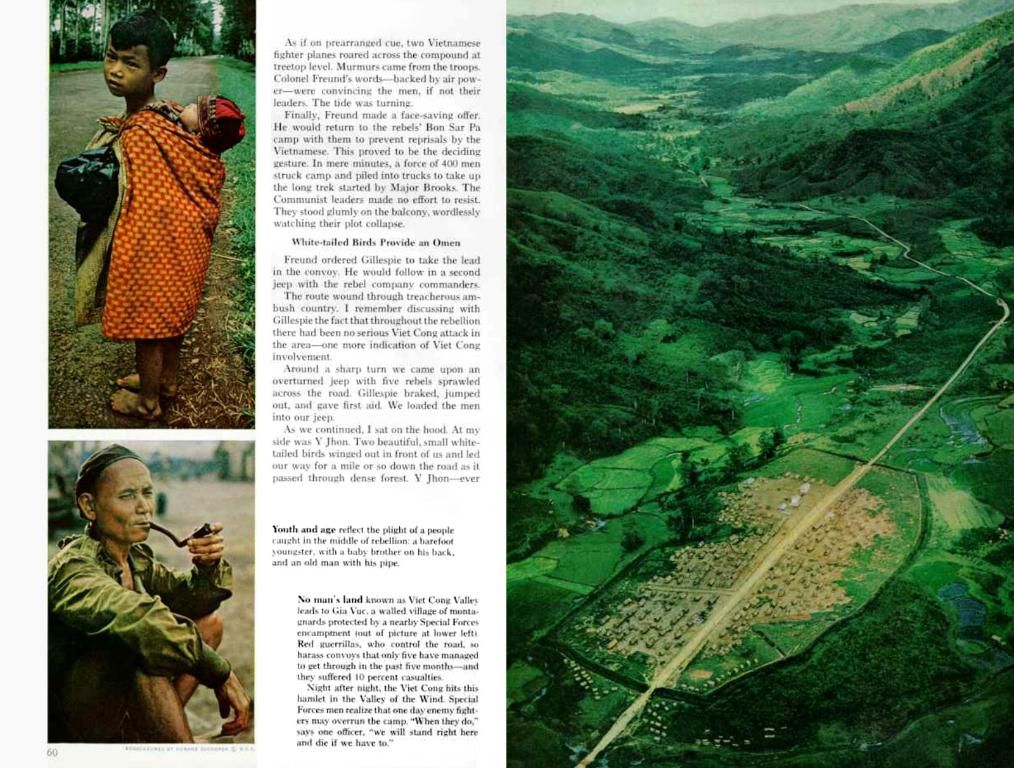Chinese J-10 fighter jet challenges Rafale's expected dominance
Fighting Power Shift: Indonesia's Pursuit of a Modern Aviation Fleet
By Alexis Fargeaudoux Published on
© Getty_Images
In the race for a more advanced aviation force, Indonesia is eyeing the Chinese Chengdu J-10C as a worthy competitor to the French Dassault Rafale. With Jakarta already securing 42 Rafale jets, will the J-10C offer a strong challenge?
Indonesia is delving deeper into modernizing its air force, and it seems the Chinese J-10C fighter jet is on their radar, as reported by The Diplomat and Paris Match. Indonesia's Defense Vice-Minister, Donny Ermawan Taufanto, confirms the 4.5 generation model is under review. "Discussions with China have taken place, they've offered us more than just fighter planes," he remarked, adding that other offers, including ships and weapon systems, are also being considered[1].
The J-10C has caught the Indonesian government's attention for its attractive price and promising performance[1]. This fighter jet has made a name for itself during the India-Pakistan conflict, with reports suggesting it may have downed a Rafale. Although controversial, this event has reignited the debate between the two aircraft[1].
Emmanuel Macron's visit at the end of May resulted in a signed letter of intent that potentially leads to the sale of additional Rafale to Indonesia, alongside the acquisition of "additional light frigates and Scorpene submarines," as well as "additional Caesar guns and their ammunition"[1]. Nevertheless, Indonesia is keen on exploring the J-10C as another option, juxtaposing cost, performance, and sovereignty[1].
So, how do the J-10C and the Rafale stack up? The J-10C boasts a higher top speed and higher service ceiling, providing advantages in high-altitude engagements. However, the Rafale excels in maneuverability due to its twin-engine setup and superior aerodynamic design[2].
In terms of avionics, the Rafale enjoys an edge, highlighted by its RBE2 AAESA radar and Spectra electronic warfare system. These features provide superior target tracking and electronic countermeasures[2]. The J-10C, while furnished with AESA radar and improved IRST systems, lags behind in terms of overall avionics prowess[2].
The Rafale is also a highly versatile aircraft capable of air superiority, ground and ship attack, reconnaissance, and nuclear deterrence, compared to the J-10C, primarily designed for air combat and interception but with secondary multi-role capabilities[4].
Recent South Asian conflicts have underlined the J-10C's abilities, yet the exact outcomes remain disputed[4]. The J-10C's performance has strengthened China's defense capabilities, while the Rafale continues to be regarded internationally as a first-rate fighter[1].
As Indonesia weighs its options, it's essential to considers both these formidable aircrafts' strengths and drawbacks, ultimately choosing the one better aligned with the country's military needs.
Footnotes:
[1] The Diplomat. (2023, Jan 31). Indonesia Exploring Chinese J-10 Fighter Jet Purchase. Retrieved from https://thediplomat.com/2023/01/indonesia-exploring-chinese-j-10-fighter-jet-purchase/
[2] KnowYourMeme. (2022, Mar 21). The Battle between J-10 and Rafale. Retrieved from https://knowyourmeme.com/memes/the-battle-between-j-10-and-rafale
[3] Naval Technology. (2022, June 24). Indonesian Rafale order nears delivery. Retrieved from https://www.naval-technology.com/projects/indonesia-rafale-fighter-jet/
[4] Avasim. (2022, Aug 15). The J-10C and the Rafale in Comparison. Retrieved from https://avasim.com/j-10c-vs-rafale-comparison/
Related Topics
- defense
- army
- Rafale
- J-10C
- air force modernization
- military capabilities
- international relations
- fighter jets
- Chinese military
- Indian military
- Pakistani military
Insights:
- The J-10C has a higher top speed and service ceiling than the Rafale.
- The Rafale's twin-engine setup makes it superior in maneuverability.
- The Rafale's avionics are considered more advanced than the J-10C's, with its RBE2 AAESA radar and Spectra electronic warfare system providing superior target tracking and electronic countermeasures.
- The J-10C is primarily designed for air combat, whereas the Rafale is highly versatile, capable of a variety of missions.
- The J-10C has performed well in conflicts in South Asia, but the exact outcomes remain disputed.
- The Rafale remains a highly regarded fighter internationally, with ongoing purchases by several countries, including Indonesia.
The J-10C, under consideration by Indonesia, showcases advanced technology in the manufacturing sector with its promising performance and attractive price point. This fighter jet, with its AESA radar and IRST systems, has potential advantages over the Rafale in terms of speed and service ceiling, but its avionics and overall capabilities may not match those of the Rafale, which boasts superior target tracking and electronic countermeasures due to its RBE2 AAESA radar and Spectra electronic warfare system. In the pursuit of modernizing its airforce, Indonesia must weigh both aircraft's strengths and drawbacks, keeping in mind the technology and manufacturing capabilities behind each, to choose the one best suited to its military needs.




